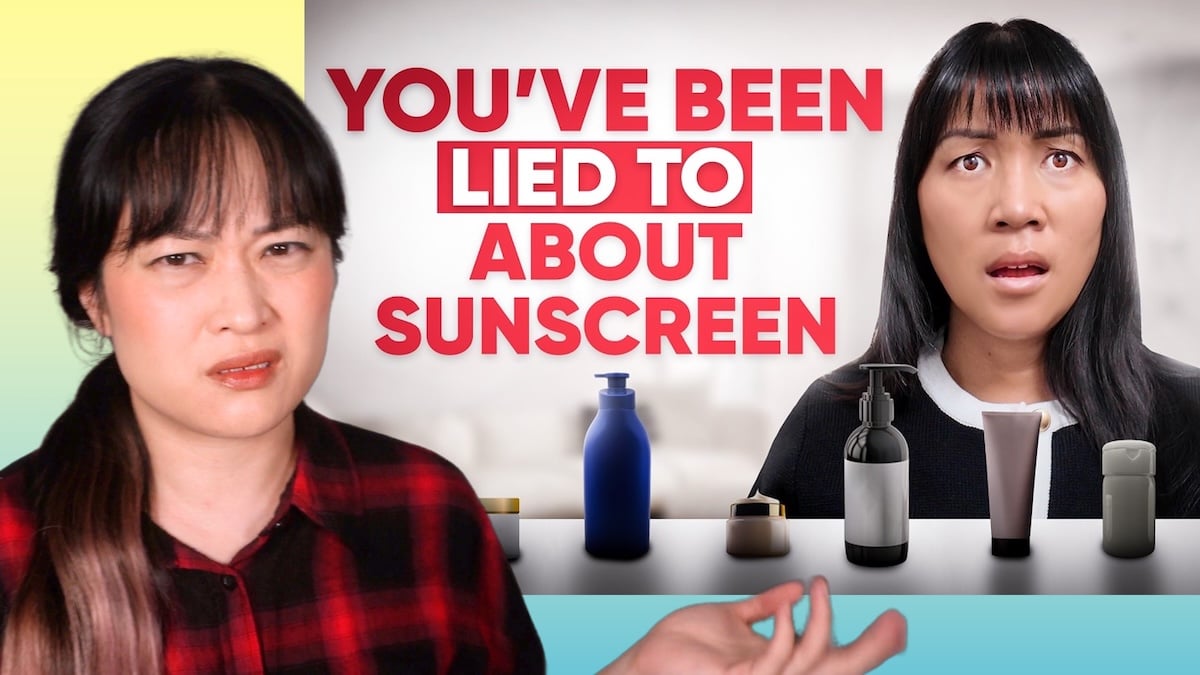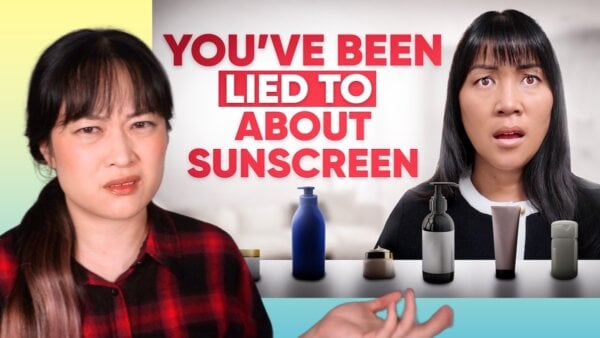Physical Address
304 North Cardinal St.
Dorchester Center, MA 02124
Physical Address
304 North Cardinal St.
Dorchester Center, MA 02124

How to cite:
Wong M. Should you avoid retinyl palmitate in sunscreens?. Lab Muffin Beauty Science. August 9, 2025. Accessed August 9, 2025.
https://labmuffin.com/retinyl-palmitate-in-sunscreens/
Does retinyl palmitate in sunscreens increase skin cancer? This is a myth that’s been promoted a lot by clean beauty organisations like the Environmental Working Group (EWG), especially in their annual sunscreen guide.
More recently, this was included as the first point in toxicologist Dr Yvonne Burkart’s video: “You’ve been lied to about sunscreen: Toxicologist reveals 6 things you should know about sunscreen”.
This is Part 1 of a response to Dr Yvonne Burkart’s video, by me and toxicologist and cosmetic safety assessor Mohammed Kanadil (@MoSkinLab on YouTube and Instagram, he also has a new Substack). We also had two experienced toxicologists check over our work (Dr Norbert Kaminski and Dr Lyle Burgoon), so this is even peer-reviewed!
The video is here, keep scrolling for the article version…

Retinyl palmitate is a form (derivative) of vitamin A. It’s been used in skincare products for decades, including in sunscreens. Some people claim that it can increase skin cancer, including Dr Yvonne Burkart:
YB: “Some [sunscreen] ingredients can actually promote skin cancer. This one is really shocking because that’s the exact opposite of what sunscreen is supposed to do. Retinyl palmitate is a synthetic form of vitamin A that’s often added to sunscreens for its so-called anti-aging benefit. You’ll see it often promoted as helping to reduce wrinkles or even to improve the texture of your skin.
But here is what is most shocking. When exposed to sunlight, retinyl palmitate becomes highly unstable, breaks down into free radicals, which are extremely reactive. These free radicals damage DNA and lipids, as well as proteins, accelerate skin aging and may even increase the risk of tumor formation over time.
In fact, studies show that retinyl palmitate when applied to the skin and exposed to sunlight generates reactive oxygen species or ROS and lipid peroxides, two well-established drivers of oxidative stress and photocarcinogenesis, which is the formation of cancer in response to sunlight.”
Based on these statements, and the phrase “when applied to the skin”, you’d perhaps expect that studies found early signs of skin cancer in humans, or at least in human skin. You’d be wrong – the evidence is actually far weaker. There are three main types she refers to:
In vitro experiments: In test tube studies, retinyl palmitate breaks down with UV exposure to form reactive oxygen species. These can damage cellular structures like DNA, leading to oxidative stress, which is one of the ways skin cancer can form.
Cell studies: Cells in petri dishes exposed to UV mutated more when retinyl palmitate was added.
Animal studies: Dr Yvonne Burkart highlights one particular animal study:
YB: “What’s even more concerning is that animal studies conducted by the National Toxicology Program found that mice whose skin was treated with retinyl palmitate and exposed to sunlight (simulated sunlight) developed significantly more skin tumors than those animals who were not exposed to the same ingredient, but still had the simulated sunlight. But yet somehow this ingredient is still included in countless mainstream products, including sunscreens, which are marketed for daily use.”
These results seem pretty concerning, but it’s important to note that these studies are pretty old, so they’ve been public knowledge for a long time. If retinyl palmitate is still found in sunscreens, it’s likely that safety assessors have considered the potential risk raised by these studies, and decided it was safe. This is indeed the case!
For example, the European Union’s Scientific Committee on Consumer Safety reviewed this data in 2016. This is a panel of very experienced scientists (mostly toxicologists) who check EU product safety. Their safety assessment (much more detailed and rigorous than a standard peer-reviewed paper) evaluated the most relevant studies including this NTP study, and outlines the reasons they don’t think retinyl palmitate is an issue in sunscreens:
Depending on what else is around it, retinyl palmitate can increase oxidative stress, or decrease it (it’s an antioxidant).
For in vitro (test tube) experiments, retinyl palmitate is usually on its own. On the other hand, skin is a complex mixture of substances, including many antioxidants. In this environment, retinyl palmitate is likely to behave very differently, and decrease oxidative stress overall.
The NTP study used hairless mice, which are very different from us humans. They’re purposely used because they’re super sensitive to UV, so they develop tumours faster and you get clear results in a shorter time. However, this means their skin also has a lot of differences that don’t translate:
On the other hand, human skin is much more adapted to sun. So for us, retinoids could actually work the other way and be protective.
Dermatologists have used retinoids for about 50 years (a lot of the evidence she shows also applies to retinol and tretinoin), and they’re actually used for preventing skin cancer. Dermatology patients get checked by dermatologists a lot, so if skin cancer was a big problem, we really should have seen more signs by now.
The NTP mouse study had some weird results that couldn’t be explained by retinyl palmitate being a problem. More UV caused less tumours, but the cream without retinyl palmitate also caused more tumours.
This could be explained by another ingredient in the base of the cream, diisopropyl adipate. This seems to cause extra UV sensitivity in hairless mice, but it’s also been tested on human skin, and this didn’t happen.
Because of these reasons, the SCCS came to the conclusion that retinyl palmitate is safe in sunscreens in both 2016 and 2022. The 2022 report also recommended restricting retinol in skincare, because it could add a little bit to the large amounts of vitamin A we get in food and supplements. So it’s not like they aren’t cautious!
Secondary sources like reviews have problems: the authors can have biases, they might leave studies out, a lot of review authors aren’t relevant experts and don’t understand the topic (sometimes they’re paper mills). For product safety, the best sources are often official reports like the SCCS safety assessments. If someone points to individual studies as evidence but leaves out these official reports, it’s a big red flag.
National Toxicology Program. Photocarcinogenesis study of retinoic acid and retinyl palmitate [CAS Nos. 302-79-4 (All-trans-retinoic acid) and 79-81-2 (All-trans-retinyl palmitate)] in SKH-1 mice (Simulated Solar Light and Topical Application Study). Natl Toxicol Program Tech Rep Ser. 2012;(568):1-352.
Tolleson WH, Cherng SH, Xia Q, et al. Photodecomposition and phototoxicity of natural retinoids. Int J Environ Res Public Health. 2005;2(1):147-155. doi:10.3390/ijerph2005010147
Mei N, Xia Q, Chen L, Moore MM, Fu PP, Chen T. Photomutagenicity of retinyl palmitate by ultraviolet a irradiation in mouse lymphoma cells. Toxicol Sci. 2005;88(1):142-149. doi:10.1093/toxsci/kfi291
Scientific Committee on Consumer Products. Opinion on Vitamin A (Retinol, Retinyl Acetate, Retinyl Palmitate). October 6, 2016.
Scientific Committee on Consumer Safety. Revision of the Scientific Opinion (SCCS/1576/16) on Vitamin A (Retinol, Retinyl Acetate, Retinyl Palmitate). October 24, 2022.